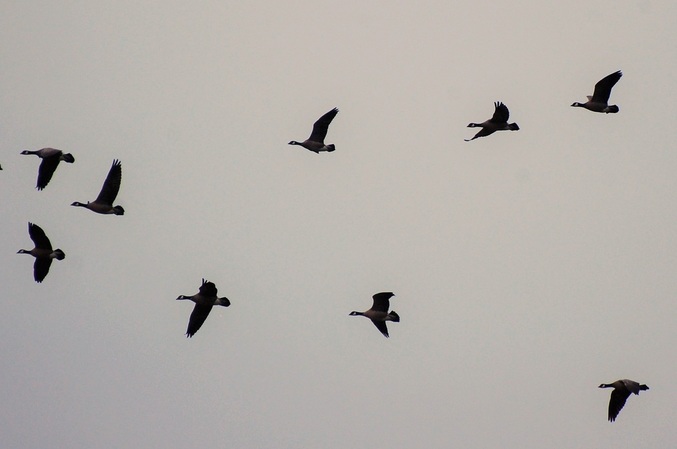 To generalize, geese and swans are on the increase North America wide and this species is no exception. Cackling Goose (Branta hutchinsii ) is recently split from their similar looking, but much larger relatives, the Canada Goose. They are small geese roughly the size of a mallard, with proportionately short necks, stubby bills and high pitched voices. For us they are mostly a bird of fall and winter. Flocks of Cackling Geese are appearing on southern Vancouver Island in larger and larger numbers, and their high pitched cackling is beginning to be a common sound as they fly over Leaning Oaks.
0 Comments
It is fall. There is no doubt. How do I know? Because the guests leave the downstairs bathroom in one of four ways: 1) come running up for a huge jar and paper to save an amazing creature, 2) come out after there is a great deal of swooshing, flapping, slapping and flushing and then casually ask a while later...uhm, do you guys normally get such HUGE spiders? 3) come running up to use an upstairs facility because there is no freaking way they are going into the downstairs room, ever, 4) run screaming from the house, tossing their bags in front of them and all we see is the red tail lights tearing down the driveway.
It is fall and Eratigena atrica is looking to mate. They are not coming to get out of the cold, they are just on the move searching for another. That they are in your sink or shower just means that they ended up there while trying to get a drink and can't get out. Their webs are flat, a bit messy and have a funnel at one end. They were introduced (accidentally I am sure) to North America from north western Europe in the early 1900's. Claudia Copley, a local spider expert demonstrates aptly in this video how there is nothing to fear from these guys; "they are our allies". There are similar spiders that are moving about this time of year, including the hobo spider. The Garry Oak Ecosystem Restoration team had this great information sheet done up to tell the difference. The scientific name has changed since this was produced and what is Tegenaria duellica in there is this species. From what I could tell, there have been a number of taxonomic revisions. 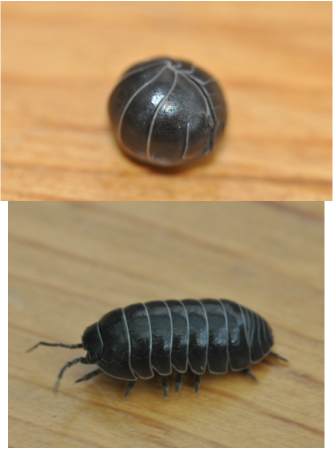 The many names by which the flat, armoured crustaceans that feed on detritus and live under pots, moist logs and leaf litter go by -and are seemingly interchangeable make me want to swear off English names forever! This is Armadillidium vulgare, and the most descriptive English name is the pillbug (or roley poley!) and you can see that when it goes into defensive mode at the sound of a spider's footsteps, it could be mistaken for a pill. In the dark. After a bender. The woodlouse (#195) can not get into this tight ball (called conglobulation). Conglobulating is not only an excellent defensive mechanism, but also conserves moisture. This is very important when your respiratory organs or pleopods are on your ventral surface. One study (in Smigal and Gibbs 2008) found that pillbugs would spontaneously conglobate at temperatures above 40 deg. C. or when in very dry soil (< 10% moisture). The females carry their eggs in a "marsupium" and even after they hatch, the young are carried until they are able to go into the world on their own. A. vulgare was introduced from Europe to North America. Smigel JT, Gibbs AG. 2008. Conglobation in the pill bug, Armadillidium vulgare, as a water conservation mechanism. 9pp. Journal of Insect Science 8:44, available online: insectscience.org/8.44 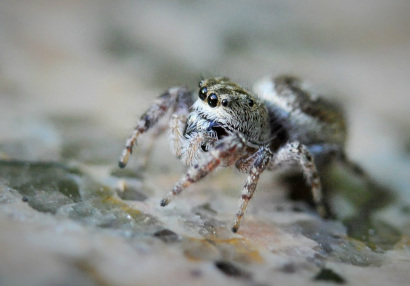 We think this jumping spider is Pelegrina aeneola, a widespread western North American species. I will admit that I couldn't find a common name for the species and just plain made this one up. Leah hates it when I make up common names*. Pelegrina refers to a famous pear-shaped pearl, discovered in the mid 1600's by an African slave in the Gulf of Panama that was "the size of a pigeon's egg". (As a reward his owner granted him his freedom). This pearl has an interesting history and was worn by the cross-dressing Rasputin to the opera, for example. The word aeneola means made from bronze - undoubtedly in reference to one of the common colour patterns found in the males of this species. This small jumping spider has most often been collected from conifer trees, although has also been found in a wide variety of other habitats. Despite the tiny size of this spider it has been recorded taking prey as large as the Common Earwig. These are photographs of a female that joined us for lunch on July 5, 2014. *She also doesn't like the term "common name" and prefers the term "English name" or "Hul'q'umi'num' name or Spanish name....or whatever. For the record. 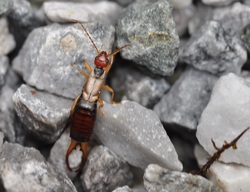 This year's long dry summer seems to have been favourable for Common Earwigs, they have caused more damage to the plants on the deck than any year I can remember. The Common Earwig (Forficula auricularia) is another introduced insect from Europe that can become a pest when their numbers are high. They are remarkably adaptable and eat fruit, foliage, insects, decaying organic matter and flowers. They can be major predators of aphids. This photo shows a male, with curved pincers at the rear to the insect. Females have straighter pincers. The origin of the name is not clear. Some say the name originated as an Old English phrase meaning "ear insect" or "ear creature," and there are old accounts of earwigs entering human ears to feed. This is dicredited by modern sources. Others conjecture it's a corruption of the phrase "ear wing," referring to the ear-like shape of the insect's hind set of wings. The pincers can be used to pinch though, although not hard enough to be a real menace. 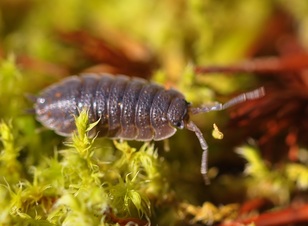 This crustacean lives under piece of wood, plant pots, beneath the moss and fallen vegetation. Wood lice (and the pillbugs or roley polies) breath through gills and live in moist areas but not in the water like the rest of their crustacean relatives. The rough texture of the plates seperate this "woodbug" from some of the others found on southern Vancouver Island. Porcellio scaber, like the other members of this group has blue blood as the result of a copper molecule in the oxygen transport molecule instead of a iron molecule like our blood. This is another common species found around houses and gardens that has been introduced from Europe. They feed on dead plant material and are generally not a pest unless they reach huge numbers. The woodlice are not able to roll into as tight a ball (or conglobulate, my new word of the day) as the "pillbugs" do (see #198). 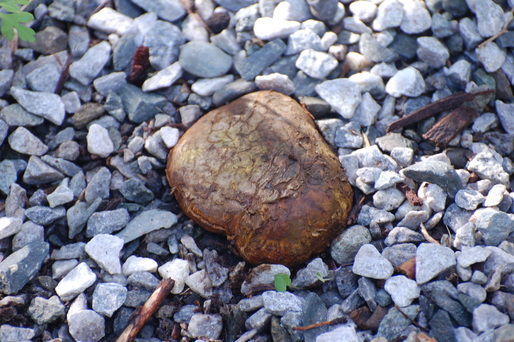 Earthballs (Scleroderma cepa) are a tough skinned, puffball-like fungus that is found in cultivated areas and paths at Leaning Oaks. They appear in late summer (in areas where we irrigate) or after the rains come in the fall in other parts of the garden. If you split them the interior is an amazing deep purple colour. Eventually they crack and split and produce large quantities of dark brown spores. Sometimes when these split they do so in a way that makes them look a messy version of an earthstar. Poisonous, but a useful ectomycorrhizal fungus used as a soil inoculant in agriculture and horticulture. 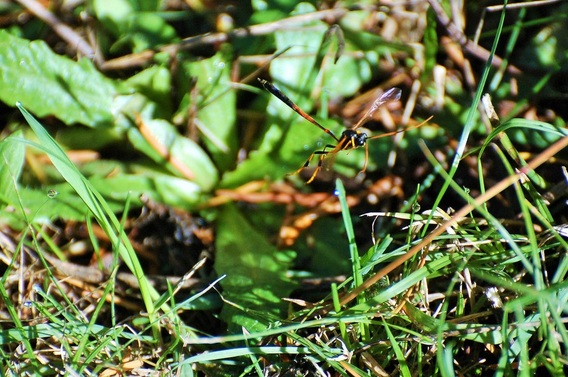 This large, long, thin black, tan and yellow wasp is a parasitoid of moth and butterfly caterpillars. This female was cruising low over grassy areas presumably looking for caterpillars when she was photographed. Wasps in the genus Therion are part of the huge and complex group of wasps known as Ichneumon wasps, all of which are parsitoids. 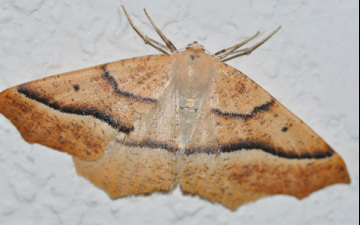 This geometrid moth seems very variable and in some of the photos that I found, the black stripes are not nearly so distinct. It flies in the autumn and the colours could be mistaken for leaves that have turned. This species of moth, Tetracis jubararia is found in western North America was far east as Saskatchewan. The larva feed on a variety of deciduous shrubs and trees including willows, alders, birch and dogwood and mimic twigs. 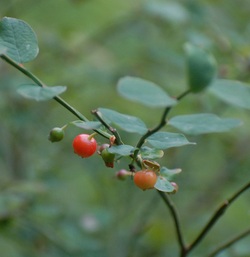 This attractive shrub is scattered throughout Leaning Oaks. Almost every one of them is perched on a decaying stump or log, which seems to be the best habitat for this species, particularly on the drier side of Vancouver Island. The graceful fern-like growth gives the impression of an evergreen because the stems are green and twiggy, but the species is, in fact, deciduous. Unlike most Vacciniums, the berries ripen a bright red instead of the usual blue, purple or black. They are sought after by birds and mammals, including humans. Red Huckleberry is slow picking because of their small size but they make excellent pies and jellies. At Leaning Oaks the recent series of dry summers has hit many of our Vaccinium parvifolium quite hard. The largest individuals have died back, or in some cases, they have succumbed. There has been some recruitment as well, including a handsome specimen on a log that forms one of the edges to our pond. 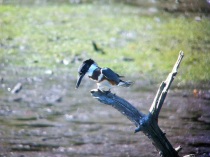 Every so often a chattering blue and white rocket speeds through the yard, does a couple of circuits over the pond and meadow and takes off again. Most of our observations of Belted Kingfishers (Megaceryle alcyon) are these brief visits, they would be easy to miss if it wasn't for the distinctive calls that this species makes. Every once in a while a Belted Kingfisher makes a stop here, usually perching over our pond, but their visits are usually brief. 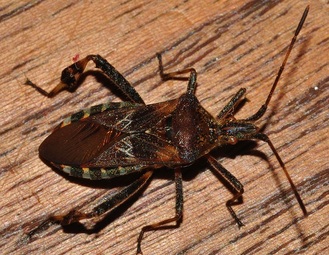 It is in the fall when Leptoglossus occidentalis wander into the house looking for a place to winter. They are large and quite spectacular with gold glitters, beautiful art deco patterns and their "leafy" legs. Throughout the summer the adults and the nymphs will feed on the seeds of conifers, and will seriously diminish seed production. This species has spread from occurring just in western North American to throughout. That spread over the past approximately 50 years is thought to have been aided by commercial pine plantations and Christmas tree and log transport. They were introduced to Northern Italy in 1999 -or at least that was when they were first noted and since have been recorded in many areas across Europe, including the United Kingdom. It is sometimes good to remind ourselves that pesky introductions have happened in both directions across the waters! 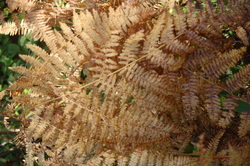 Fall is the time when Bracken Fern (Pteridium aquilinum) is most notable, as the fronds turn from green to an attractive tan. While an attractive native fern, it is a bit of a thug in the garden, where vigorous growth and long underground runners make it a difficult species to manage. Formerly the fiddleheads (the unfurled young shoots) were picked and used as a spring vegetable;however, the consumption of Bracken has been linked to stomach cancer and breakdown of Vitamin B, so it is no longer recommended for human consumption. Indeed, very little seems to eat Bracken in the wild - I seldom find a stem chewed by any sort of herbivore. Studies in the UK and South America indicate only a small number of insects consume the species -and they tend to be highly specialized. Bracken is one of the most widely distributed species in the world..we have hiked through Bracken in the highlands of New Guinea and the Andes of Venezuela, the French countryside and cooler areas in Australia.  And there will likely be more crane flies - perhaps sp 1, sp 2 and so on unless I get better at the identifying! There are 171 described species in 53 genera in BC. and worldwide there are over 15,000 described species making it the most speciose family of Diptera ("flies"). I did figure out that this was not one of the introduced species, but potentially Tipula pseudotruncorum or T. dorsimaculata. I'd be thrilled if there was anyone that would like to weigh in with an ID! There was an explosion of the Marsh Crane Fly, an introduction from Europe on the coast a number of years ago and the larvae or "leatherjackets" caused a lot of damage to roots of many plants. The crane flies fly mainly when it is cooler -dusk around Leaning Oaks and are a food source for many birds, spiders, amphibians and other insects. They always seem a bit clumsy to me and legs will break off at the slightest bump. I watched this one for sometime wiggle its long rostrum, drinking what specks of water it could find. 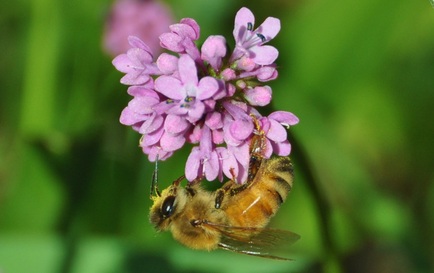 Domestic honey bees, Apis mellifera were introduced to the east coast of North America from Europe in 1622. Aided by settlers it took a couple of 100 years before they reached the west coast. Today they are found across the continent with both domestic and feral populations. Because of their importance to the settlers their path has been well documented. We don't know if the ones visiting Leaning Oaks are from hives or a population that has naturalized. I have seen estimates that up to 80% of all crops in North America are dependent on bee pollination -both native and non-native. There are many other groups of pollinators in addition to the bees, but they do play an important role in agriculture. 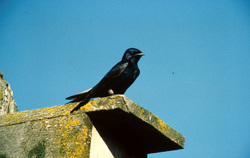 This morning I had a Purple Martin (Progne subis) calling from high over the house, our latest fall record ever. This species is a conservation success story on southern Vancouver Island. Nowadays the twangy call of a Purple Martin high overhead is a common noise on southern Vancouver Island, but not very long ago this species had almost disappeared from British Columbia. Purple Martins declined in the 1940's likely due to competition for nest sites with European Starlings. Thanks to the efforts of a group of volunteers, nesting boxes put onto pilings has increased the number of nest sites and the number of Purple Martins has gone up in the province. It is now the second commonest swallow detected at Leaning Oaks, after Violet-green Swallows. 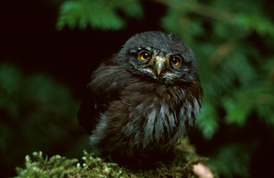 At dawn this morning the first bird noise I heard was the distinctive "toot, toot, toot" call of a Northern Pygmy-Owl. While Northern Pygmy-Owls ( Glaucidium gnoma swarthi ) have bred not far from us, all of our records are from the fall (late August to October). We suspect this is because there is a largely undetected post-breeding movement of these tiny owls away from breeding locations. Unlike most owls, Pgymy-Owls are often daytime active. It is a combination of hearing the birds and finding them as they are being mobbed by songbirds that leads to most of our detections. Agitated small birds are almost always a sign that something interesting is going on at Leaning Oaks. This subspecies of Northern Pygmy-Owl is endemic to Vancouver Island and the Gulf Islands. 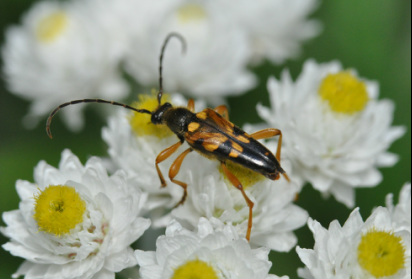 The flower longhorn beetles feed on nectar and pollen as adults and as larvae will feed on dead or dying wood, the digestion of the cellulose aided by enzymes. They appeared for about three or four days on the pearly everlasting and whether that was their life span or they moved on to other food sources - we don't know. I believe that this is Xestoleptura crassipes, one of three of this genus found in B.C.. 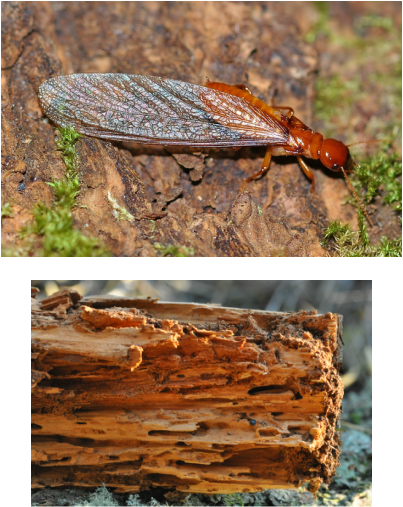 The end of summer is ushered in by the erratic flight of dampwood termites just before sunset. This bounty is a source of food for many birds and we have had the pleasure of sitting on the beach watching Bonaparte's Gulls gorging on Zootermopsis angusticollis. The winged form is called the alate and when they lose their wings they are de-alate (seriously!). These are sexually reproductive animals that use their wings for dispersal and will drop them upon landing. The gut of the termite is filled with microbes that are able to covert the fibrous wood material into something that will provide nutrition for the termite. This process is called acetogenesis. The Tarspots are a group of fungi that infect leaves. This one (Rhytisma punctatum) is a common, but relatively benign, fungus that infects Bigleaf Maple. It is most notable in the fall when the leaves of Bigleaf Maple start to fall. At this time of year one can clearly see the black, tarry areas where the fungus sporulates. The fungus protects the chlorophyll in the leaf from the usual breakdown by bacteria that an autumn leaf experiences. This leaves a green spot in the infected area while the rest of the leaf turns yellow. The result is interesting and sometimes attractive patterns on the carpet of maple leaves on the forest floor. Today was the first day I noticed significant numbers of Bigleaf Maple leaves on the ground - another sure sign that summer is truly over.
|
AuthorsTwo biologists on a beautiful property armed with cameras, smart phones and a marginal knowledge of websites took up the challenge of documenting one species a day on that property. Join along! Posts and photographs by Leah Ramsay and David Fraser (unless otherwise stated); started January 1, 2014. Categories
All
Archives
May 2025
|
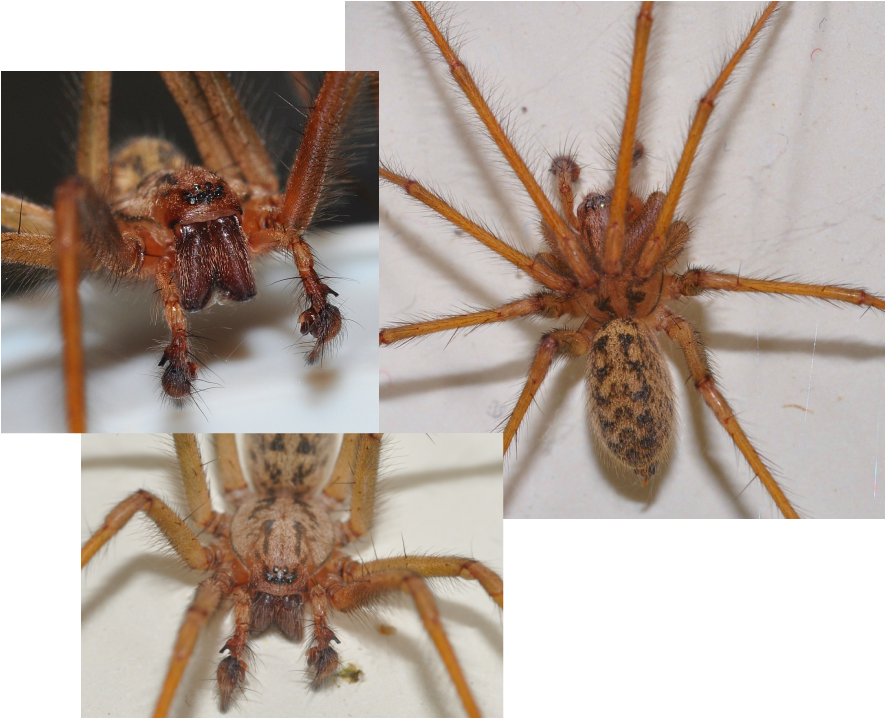
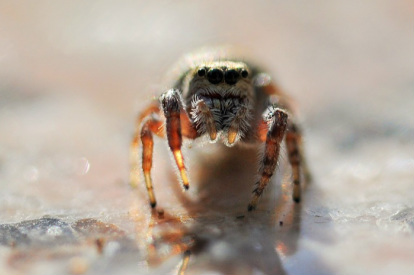
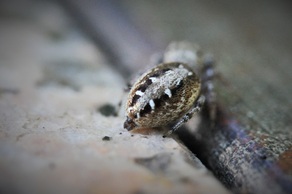
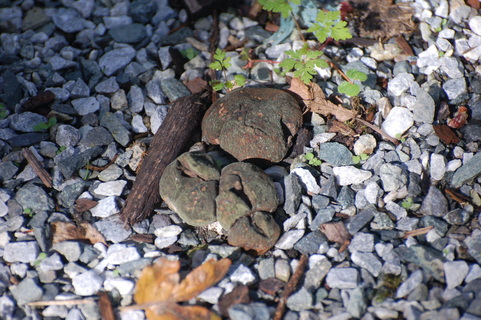
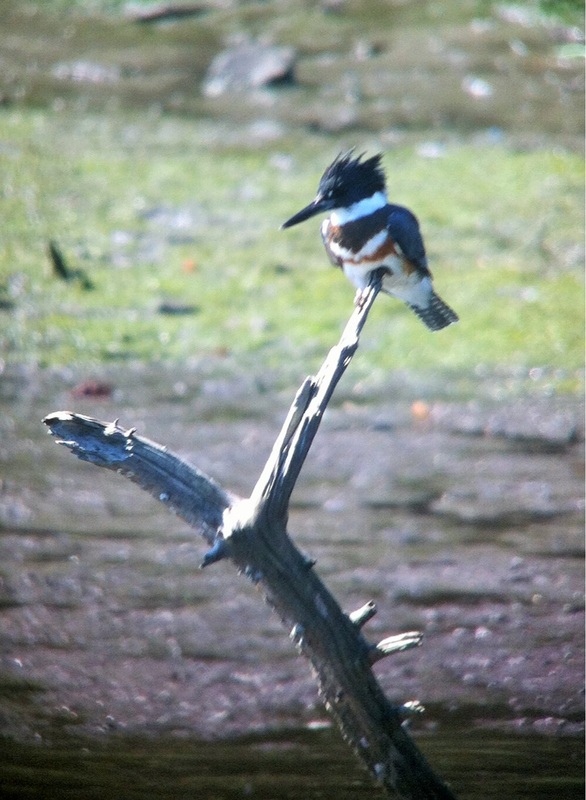
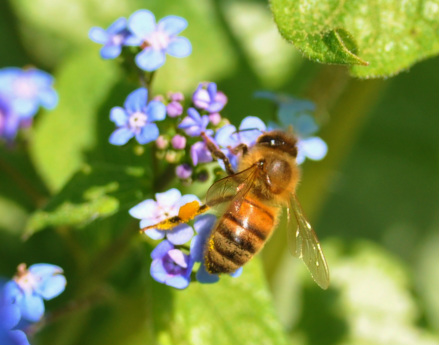
 RSS Feed
RSS Feed